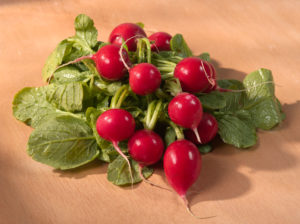What's the Dish on Radishes?
For most individuals, radishes are the crispy root vegetable occasionally found on a garden salad. However, the radish has the potential to be so much more! For example, a side-dish all it’s own, a topping for tacos or sandwiches, or a main ingredient in a salad.
Radish Varieties
Numerous types of radishes are available in various sizes, colors and shapes. Radishes make a great vegetable choice for dialysis patients as they are low in phosphorus and potassium.
| Radish Type | Description | Nutrition Content per 1/2 cup, sliced (58 grams) | |
| Potassium (mg) | Phosphorus (mg) | ||
| Cherry Belle (Fresh) | Bright red with a white interior, round radish and 2 inches in diameter | 135 | 12 |
| Icicle (Fresh) | White radish with a pungent taste and 5 to 8 inches in length | 132 | 13 |
| Daikon/Chinese/Oriental
(Fresh) |
White radish, resembling a pale carrot, with a milder taste | 132 | 13 |
Recipe and Serving Ideas
 Radishes can make an appearance in your next dish by testing out a DaVita.com recipe. For a kidney-friendly quick radish salad, try this Cucumber and Radish Salad recipe. You can also consider serving radishes on a vegetable tray for your next party. This recipe for Garden Veggie Dip pairs nicely with a variety of vegetables, including radishes. You may also want to try the recipe for Sinigang, a Filipino stew that incorporates the daikon radish. Last, radishes can easily be turned into a side-dish by adding a little oil and pepper and simply roasting or grilling them.
Radishes can make an appearance in your next dish by testing out a DaVita.com recipe. For a kidney-friendly quick radish salad, try this Cucumber and Radish Salad recipe. You can also consider serving radishes on a vegetable tray for your next party. This recipe for Garden Veggie Dip pairs nicely with a variety of vegetables, including radishes. You may also want to try the recipe for Sinigang, a Filipino stew that incorporates the daikon radish. Last, radishes can easily be turned into a side-dish by adding a little oil and pepper and simply roasting or grilling them.
To keep your radishes fresh, cut off the green leafy tops just above where the stems meet the roots. Store the roots unwashed in a sealed container in the refrigerator for up to two weeks. For longer storage up to one month, place the roots along with a damp paper towel in a sealed container in a cool, moist, dark place. Be sure to wash the roots prior to enjoying.
Radish Leaves
Do not toss the leaves quite yet. Radish tops are also edible, but their nutritional context is different from the roots. The leaves are higher in potassium but still an acceptable food choice when portion size is kept in check. Radish tops can be eaten like other salad greens. Just be sure to plan on eating the leaves within one to two days after separating them from the roots.
| Radish Leaves (Fresh) | Nutrition Content per 2 ounces (58 Grams) | |
| Potassium 215 mg | Phosphorus 26 mg | |
Now that you know the dish on radishes, you can dish up some radishes for you and your family – they might just like them.

Recent Comments